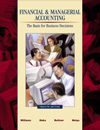Chapter 23 - Summary LO 1 Explain how standard costs assist managers in controlling costs. Standard costs are the expected (or budgeted) costs per unit. When standard
costs are used in a cost accounting system, differences between actual costs
and standard costs promptly are brought to management's attention. LO 2 Explain the difference between setting ideal standards and setting reasonably
achievable standards. The most widely used approach is to set budgeted amounts at levels that are
reasonably achievable under normal operating conditions. The goal in this case
is to make the cost standard a fair and reasonable basis for evaluating performance. An alternative is to budget an ideal level of performance. Under this approach,
departments normally fall somewhat short of budgeted performance, but the variations
may identify areas in which improvement is possible. LO 3 Compute variable cost variances and explain the meaning of each. Cost variances are computed by comparing actual costs to standard costs and
explaining the reasons for any differences. Differences in the cost of materials
used may be caused either by variations in the price paid to purchase materials
or in the quantity of materials used. Differences in the cost of direct labor
may be caused by variations in wage rates or in the number of hours worked.
Variances from budgeted levels of variable overhead may be caused by differences
in outlays for controllable overhead expenditures or in the actual and budgeted
levels of production. LO 4 Compute fixed cost variances and explain the meaning of each. To compute fixed overhead cost variances, compare the actual fixed overhead
to the budgeted fixed overhead and compare the budgeted fixed overhead to the
applied fixed overhead. Fixed cost variances can result from spending more than
budgeted in fixed cost categories or from a difference between the projected
volume used to create the overhead application rate and the actual production
used to apply overhead. LO 5 Discuss the causes of specific cost variances. Materials variances may be caused by the quality and price of materials purchased
and by the efficiency with which these materials are used. Labor variances stem
from workers' productivity, pay scales of workers placed on the job, and the
quality of the materials with which they work. Overhead variances result both
from actual spending and from differences between actual and normal levels of
production. | 


 2002 McGraw-Hill Higher Education
2002 McGraw-Hill Higher Education